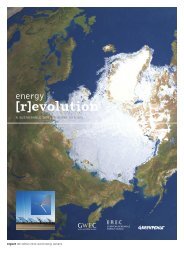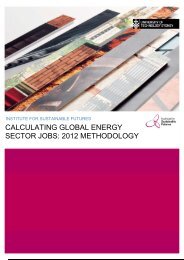download the mexico energy revolution scenario
download the mexico energy revolution scenario
download the mexico energy revolution scenario
You also want an ePaper? Increase the reach of your titles
YUMPU automatically turns print PDFs into web optimized ePapers that Google loves.
image BROWN COAL SURFACE MINING<br />
IN HAMBACH, GERMANY. GIANT COAL<br />
EXCAVATOR AND SPOIL PILE.<br />
© ARNOLD/VISUM/GP<br />
nuclear technologies<br />
Generating electricity from nuclear power involves transferring <strong>the</strong><br />
heat produced by a controlled nuclear fission reaction into a<br />
conventional steam turbine generator. The nuclear reaction takes<br />
place inside a core and surrounded by a containment vessel of<br />
varying design and structure. Heat is removed from <strong>the</strong> core by a<br />
coolant (gas or water) and <strong>the</strong> reaction controlled by a moderating<br />
element or “moderator”.<br />
Across <strong>the</strong> world over <strong>the</strong> last two decades <strong>the</strong>re has been a general<br />
slowdown in building new nuclear power stations. This has been<br />
caused by a variety of factors: fear of a nuclear accident, following<br />
<strong>the</strong> events at Three Mile Island, Chernobyl and Monju, increased<br />
scrutiny of economics and environmental factors, such as waste<br />
management and radioactive discharges.<br />
nuclear reactor designs: evolution and safety issues At <strong>the</strong><br />
beginning of 2005 <strong>the</strong>re were 441 nuclear power reactors operating<br />
in 31 countries around <strong>the</strong> world. Although <strong>the</strong>re are dozens of<br />
different reactor designs and sizes, <strong>the</strong>re are three broad categories<br />
ei<strong>the</strong>r currently deployed or under development. These are:<br />
Generation I: Prototype commercial reactors developed in <strong>the</strong><br />
1950s and 1960s as modified or enlarged military reactors,<br />
originally ei<strong>the</strong>r for submarine propulsion or plutonium production.<br />
Generation II: Mainstream reactor designs in commercial<br />
operation worldwide.<br />
Generation III: New generation reactors now being built.<br />
Generation III reactors include <strong>the</strong> so-called Advanced Reactors,<br />
three of which are already in operation in Japan, with more under<br />
construction or planned. About 20 different designs are reported to<br />
be under development 67 , most of <strong>the</strong>m ‘evolutionary’ designs<br />
developed from Generation II reactor types with some<br />
modifications, but without introducing drastic changes. Some of<br />
<strong>the</strong>m represent more innovative approaches. According to <strong>the</strong> World<br />
Nuclear Association, reactors of Generation III are characterised<br />
by <strong>the</strong> following:<br />
• A standardised design for each type to expedite licensing, reduce<br />
capital cost and construction time.<br />
• A simpler and more rugged design, making <strong>the</strong>m easier to<br />
operate and less vulnerable to operational upsets.<br />
• Higher availability and longer operating life, typically 60 years.<br />
• Reduced possibility of core melt accidents.<br />
• Minimal effect on <strong>the</strong> environment.<br />
• Higher burn-up to reduce fuel use and <strong>the</strong> amount of waste.<br />
• Burnable absorbers (‘poisons’) to extend fuel life.<br />
To what extent <strong>the</strong>se goals address issues of higher safety<br />
standards, as opposed to improved economics, remains unclear.<br />
Of <strong>the</strong> new reactor types, <strong>the</strong> European Pressurised Water Reactor<br />
(EPR) has been developed from <strong>the</strong> most recent Generation II<br />
designs to start operation in France and Germany. 68 Its stated goals<br />
are to improve safety levels - in particular to reduce <strong>the</strong> probability<br />
of a severe accident by a factor of ten, achieve mitigation from<br />
severe accidents by restricting <strong>the</strong>ir consequences to <strong>the</strong> plant<br />
itself, and reduce costs. Compared to its predecessors, however, <strong>the</strong><br />
EPR displays several modifications which constitute a reduction of<br />
safety margins, including:<br />
• The volume of <strong>the</strong> reactor building has been reduced by<br />
simplifying <strong>the</strong> layout of <strong>the</strong> emergency core cooling system, and<br />
by using <strong>the</strong> results of new calculations which predict less<br />
hydrogen development during an accident.<br />
• The <strong>the</strong>rmal output of <strong>the</strong> plant has been increased by 15%<br />
relative to existing French reactors by increasing core outlet<br />
temperature, letting <strong>the</strong> main coolant pumps run at higher<br />
capacity and modifying <strong>the</strong> steam generators.<br />
• The EPR has fewer redundant pathways in its safety systems<br />
than a German Generation II reactor.<br />
Several o<strong>the</strong>r modifications are hailed as substantial safety<br />
improvements, including a ‘core catcher’ system to control a<br />
meltdown accident. None<strong>the</strong>less, in spite of <strong>the</strong> changes being<br />
envisaged, <strong>the</strong>re is no guarantee that <strong>the</strong> safety level of <strong>the</strong> EPR<br />
actually represents a significant improvement. In particular,<br />
reduction of <strong>the</strong> expected core melt probability by a factor of ten is<br />
not proven. Fur<strong>the</strong>rmore, <strong>the</strong>re are serious doubts as to whe<strong>the</strong>r <strong>the</strong><br />
mitigation and control of a core melt accident with <strong>the</strong> core catcher<br />
concept will actually work.<br />
Finally, Generation IV reactors are currently being developed with<br />
<strong>the</strong> aim of commercialisation in 20-30 years.<br />
8<br />
<strong>energy</strong> technologies | NUCLEAR TECHNOLOGIES<br />
67 IAEA 2004; WNO 2004A.<br />
68 HAINZ 2004.<br />
91



![Energy [R]evolution - European Commission](https://img.yumpu.com/49109324/1/184x260/energy-revolution-european-commission.jpg?quality=85)


![5905 gp [eu rev]csfr4.qxd - Energy [R]evolution](https://img.yumpu.com/42305023/1/184x260/5905-gp-eu-revcsfr4qxd-energy-revolution.jpg?quality=85)


![5905 gp [eu rev]csfr4.qxd - Energy [R]evolution](https://img.yumpu.com/28729264/1/184x260/5905-gp-eu-revcsfr4qxd-energy-revolution.jpg?quality=85)